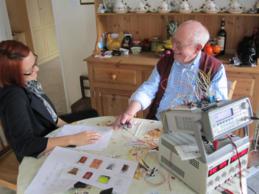
| Home | About | Research | Publications | Links |
Haptic Devices for Stroke Rehabilitation
Principal Investigator: Dr Geoff Merrett
Project Team: Dr Sara Demain, Dr Cheryl Metcalf, Sarah Cunningham, Deyi Zheng & Stuart Barrow
Date: 2010
Project Team: Dr Sara Demain, Dr Cheryl Metcalf, Sarah Cunningham, Deyi Zheng & Stuart Barrow
Date: 2010
Background
Sensory feedback is essential for motor learning and critical to recovery from neurological impairment, such as stroke. In neurological conditions, sensory deficits are often present, limiting the potential for recovery. Current understanding of neuroplasticity would support the argument that sensory, cutaneous input (stimulation that is applied to the skin) may enhance sensory-motor learning. Current rehabilitation robots use interfaces, such as virtual reality, to increase patient motivation during therapy. However, these systems do not give tactile feedback as you would normally experience when you grasp or interact with a real object. There is a need to design a system for effective recovery of reaching and grasping following stroke that is compatible with a range of rehabilitation robots, is low-cost and can translate between hospital or home use.
In humans, haptic sensory information is both tactile (related to contact and pressure) and kinaesthetic (related to position and motion). A range of different technologies, devices, methods and techniques have been proposed for providing a realistic tactile feedback to the fingertip, and a range of these will be investigated in this project. Other applications of the technology are in virtual reality for computer aided design and gaming. The objective of this project was to employ an iterative, user-led method to design a series of haptic devices using several modalities.
In humans, haptic sensory information is both tactile (related to contact and pressure) and kinaesthetic (related to position and motion). A range of different technologies, devices, methods and techniques have been proposed for providing a realistic tactile feedback to the fingertip, and a range of these will be investigated in this project. Other applications of the technology are in virtual reality for computer aided design and gaming. The objective of this project was to employ an iterative, user-led method to design a series of haptic devices using several modalities.
User-led Design/Human Factors
The haptics project adopted a user-led approach to device development. The developed devices were evaluated through human studies to ascertain which provide the most realistic and usable sensations for use in stroke rehabilitation.

For more information on methods of user-led design, please contact Sara Demain.
For more information on methods of user-led design, please contact Sara Demain.
Project Progress
Each device was evaluated by iterative testing with unimpaired participants and stroke patients to identify which mechanism(s) provide a realistic sensation and satisfies aesthetic, comfort, reliability and calibration considerations. The project also investigated the development and evaluation of a wearable system for providing tactile feedback to all fingers on a hand, and can potentially be used as a stand alone system or integrated with existing rehabilitation technologies, such as rehabilitation robots.
For more information on the Haptics Project, please contact Geoff Merrett.
For more information on the Haptics Project, please contact Geoff Merrett.
Publications
Merrett, G.V., Metcalf, C.D., Cunningham, S., Zheng, D., Barrow, S. & Demain, S.H., 2011. Design and Qualitative Evaluation of Tactile Devices for Stroke Rehabilitation. IET Assisted Living Conference 2011. London: UK. 6 April. ISBN: 978-1-84919-469-3.

